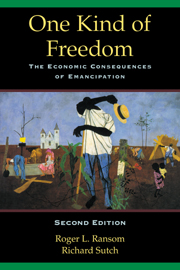Book contents
- Frontmatter
- Contents
- Preface
- Preface to the new edition
- Acknowledgments
- A note to the reader
- Chapter 1 What did freedom mean?
- Chapter 2 The legacy of slavery
- Chapter 3 The myth of the prostrate South
- Chapter 4 The demise of the plantation
- Chapter 5 Agricultural reconstruction
- Chapter 6 Financial reconstruction
- Chapter 7 The emergence of the merchants' territorial monopoly
- Chapter 8 The trap of debt peonage
- Chapter 9 The roots of southern poverty
- STATISTICAL APPENDIXES
- Appendix A Construction of income and welfare estimates: 1859–1899
- Appendix B Occupational distribution of southern blacks: 1860, 1870, 1890
- Appendix C Estimates of labor supplied by slave and free labor
- Appendix D Calculation of interest charged for credit implicit in the dual-price system
- Appendix E Calculation of food residuals on southern farms: 1880
- Appendix F Estimates of per capita gross crop output: 1859–1908
- DATA APPENDIX
- Epilogue
- A Bibliography of Literature on the South after 1977
- Notes
- Bibliography
- Index
Appendix F - Estimates of per capita gross crop output: 1859–1908
Published online by Cambridge University Press: 05 October 2013
- Frontmatter
- Contents
- Preface
- Preface to the new edition
- Acknowledgments
- A note to the reader
- Chapter 1 What did freedom mean?
- Chapter 2 The legacy of slavery
- Chapter 3 The myth of the prostrate South
- Chapter 4 The demise of the plantation
- Chapter 5 Agricultural reconstruction
- Chapter 6 Financial reconstruction
- Chapter 7 The emergence of the merchants' territorial monopoly
- Chapter 8 The trap of debt peonage
- Chapter 9 The roots of southern poverty
- STATISTICAL APPENDIXES
- Appendix A Construction of income and welfare estimates: 1859–1899
- Appendix B Occupational distribution of southern blacks: 1860, 1870, 1890
- Appendix C Estimates of labor supplied by slave and free labor
- Appendix D Calculation of interest charged for credit implicit in the dual-price system
- Appendix E Calculation of food residuals on southern farms: 1880
- Appendix F Estimates of per capita gross crop output: 1859–1908
- DATA APPENDIX
- Epilogue
- A Bibliography of Literature on the South after 1977
- Notes
- Bibliography
- Index
Summary
The only previous attempt of which we are aware to measure aggregate per capita agricultural income for the South in the late nineteenth century is Richard Easterlin's estimates of ”agricultural service income per worker” for 1880 and 1900. Easterlies calculations are based on Carol Brainerd and Ann Miller's estimates of the number of agricultural workers per state, on the census reports of the aggregate value of farm products produced in each state in 1879 and 1899, and on estimates of national agricultural service income for 1880 and 1900. The farm product figures from the census were used to partition and distribute to each state the estimate of the agricultural service income for the entire country. Agricultural service income for the United States was based upon Robert Martin's estimates.
Easterlin's estimates put average agricultural service income in the Five Cotton States at $254.35 in 1880 and $258.30 in 1900, both measured in 1929 dollars. This suggests that agricultural productivity in these states grew at a rate less than 0.08 percent per year during the last two decades of the century. Easterlin's estimates of per capita personal income in the Five Cotton States for 1880 and 1900 hardly present a more favorable view of southern development in this period. In 1929 dollars, per capita income increased from $156.06 to $185.25, representing a rate of growth of only 0.86 percent per annum, little more than one-half the national rate of growth.
- Type
- Chapter
- Information
- One Kind of FreedomThe Economic Consequences of Emancipation, pp. 254 - 270Publisher: Cambridge University PressPrint publication year: 2001

